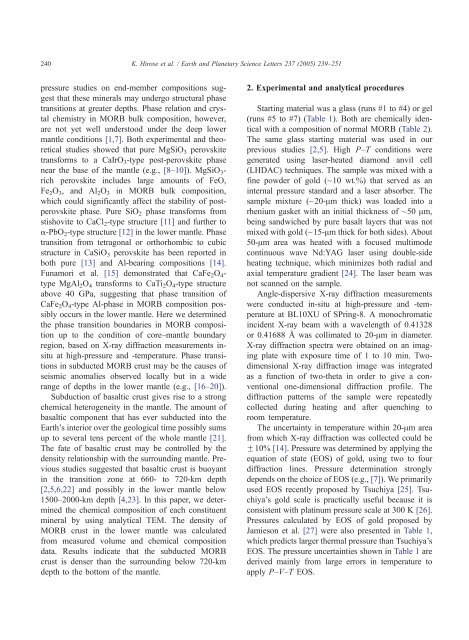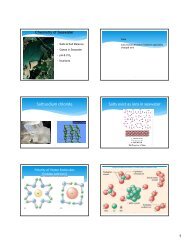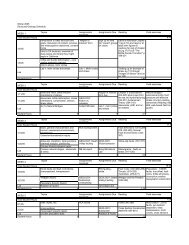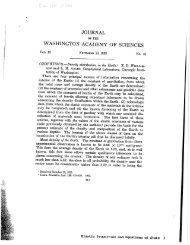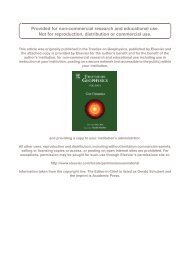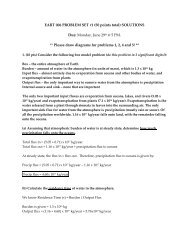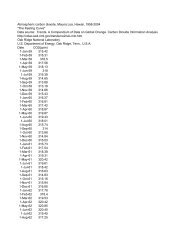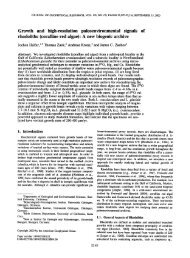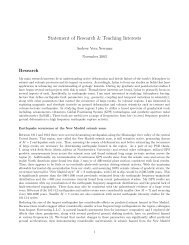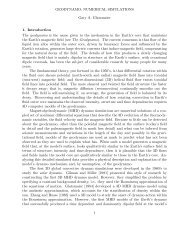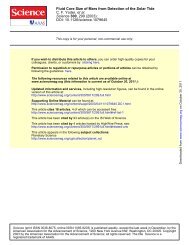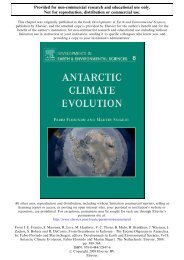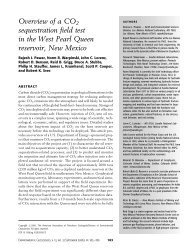Phase transition and density of subducted MORB crust in the lower ...
Phase transition and density of subducted MORB crust in the lower ...
Phase transition and density of subducted MORB crust in the lower ...
Create successful ePaper yourself
Turn your PDF publications into a flip-book with our unique Google optimized e-Paper software.
240<br />
K. Hirose et al. / Earth <strong>and</strong> Planetary Science Letters 237 (2005) 239–251<br />
pressure studies on end-member compositions suggest<br />
that <strong>the</strong>se m<strong>in</strong>erals may undergo structural phase<br />
<strong>transition</strong>s at greater depths. <strong>Phase</strong> relation <strong>and</strong> crystal<br />
chemistry <strong>in</strong> <strong>MORB</strong> bulk composition, however,<br />
are not yet well understood under <strong>the</strong> deep <strong>lower</strong><br />
mantle conditions [1,7]. Both experimental <strong>and</strong> <strong>the</strong>oretical<br />
studies showed that pure MgSiO3 perovskite<br />
transforms to a CaIrO3-type post-perovskite phase<br />
near <strong>the</strong> base <strong>of</strong> <strong>the</strong> mantle (e.g., [8–10]). MgSiO 3rich<br />
perovskite <strong>in</strong>cludes large amounts <strong>of</strong> FeO,<br />
Fe 2O 3, <strong>and</strong> Al 2O 3 <strong>in</strong> <strong>MORB</strong> bulk composition,<br />
which could significantly affect <strong>the</strong> stability <strong>of</strong> postperovskite<br />
phase. Pure SiO2 phase transforms from<br />
stishovite to CaCl2-type structure [11] <strong>and</strong> fur<strong>the</strong>r to<br />
a-PbO2-type structure [12] <strong>in</strong> <strong>the</strong> <strong>lower</strong> mantle. <strong>Phase</strong><br />
<strong>transition</strong> from tetragonal or orthorhombic to cubic<br />
structure <strong>in</strong> CaSiO 3 perovskite has been reported <strong>in</strong><br />
both pure [13] <strong>and</strong> Al-bear<strong>in</strong>g compositions [14].<br />
Funamori et al. [15] demonstrated that CaFe 2O 4type<br />
MgAl2O4 transforms to CaTi2O4-type structure<br />
above 40 GPa, suggest<strong>in</strong>g that phase <strong>transition</strong> <strong>of</strong><br />
CaFe2O4-type Al-phase <strong>in</strong> <strong>MORB</strong> composition possibly<br />
occurs <strong>in</strong> <strong>the</strong> <strong>lower</strong> mantle. Here we determ<strong>in</strong>ed<br />
<strong>the</strong> phase <strong>transition</strong> boundaries <strong>in</strong> <strong>MORB</strong> composition<br />
up to <strong>the</strong> condition <strong>of</strong> core–mantle boundary<br />
region, based on X-ray diffraction measurements <strong>in</strong>situ<br />
at high-pressure <strong>and</strong> -temperature. <strong>Phase</strong> <strong>transition</strong>s<br />
<strong>in</strong> <strong>subducted</strong> <strong>MORB</strong> <strong>crust</strong> may be <strong>the</strong> causes <strong>of</strong><br />
seismic anomalies observed locally but <strong>in</strong> a wide<br />
range <strong>of</strong> depths <strong>in</strong> <strong>the</strong> <strong>lower</strong> mantle (e.g., [16–20]).<br />
Subduction <strong>of</strong> basaltic <strong>crust</strong> gives rise to a strong<br />
chemical heterogeneity <strong>in</strong> <strong>the</strong> mantle. The amount <strong>of</strong><br />
basaltic component that has ever <strong>subducted</strong> <strong>in</strong>to <strong>the</strong><br />
Earth’s <strong>in</strong>terior over <strong>the</strong> geological time possibly sums<br />
up to several tens percent <strong>of</strong> <strong>the</strong> whole mantle [21].<br />
The fate <strong>of</strong> basaltic <strong>crust</strong> may be controlled by <strong>the</strong><br />
<strong>density</strong> relationship with <strong>the</strong> surround<strong>in</strong>g mantle. Previous<br />
studies suggested that basaltic <strong>crust</strong> is buoyant<br />
<strong>in</strong> <strong>the</strong> <strong>transition</strong> zone at 660- to 720-km depth<br />
[2,5,6,22] <strong>and</strong> possibly <strong>in</strong> <strong>the</strong> <strong>lower</strong> mantle below<br />
1500–2000-km depth [4,23]. In this paper, we determ<strong>in</strong>ed<br />
<strong>the</strong> chemical composition <strong>of</strong> each constituent<br />
m<strong>in</strong>eral by us<strong>in</strong>g analytical TEM. The <strong>density</strong> <strong>of</strong><br />
<strong>MORB</strong> <strong>crust</strong> <strong>in</strong> <strong>the</strong> <strong>lower</strong> mantle was calculated<br />
from measured volume <strong>and</strong> chemical composition<br />
data. Results <strong>in</strong>dicate that <strong>the</strong> <strong>subducted</strong> <strong>MORB</strong><br />
<strong>crust</strong> is denser than <strong>the</strong> surround<strong>in</strong>g below 720-km<br />
depth to <strong>the</strong> bottom <strong>of</strong> <strong>the</strong> mantle.<br />
2. Experimental <strong>and</strong> analytical procedures<br />
Start<strong>in</strong>g material was a glass (runs #1 to #4) or gel<br />
(runs #5 to #7) (Table 1). Both are chemically identical<br />
with a composition <strong>of</strong> normal <strong>MORB</strong> (Table 2).<br />
The same glass start<strong>in</strong>g material was used <strong>in</strong> our<br />
previous studies [2,5]. High P–T conditions were<br />
generated us<strong>in</strong>g laser-heated diamond anvil cell<br />
(LHDAC) techniques. The sample was mixed with a<br />
f<strong>in</strong>e powder <strong>of</strong> gold (~10 wt.%) that served as an<br />
<strong>in</strong>ternal pressure st<strong>and</strong>ard <strong>and</strong> a laser absorber. The<br />
sample mixture (~20-Am thick) was loaded <strong>in</strong>to a<br />
rhenium gasket with an <strong>in</strong>itial thickness <strong>of</strong> ~50 Am,<br />
be<strong>in</strong>g s<strong>and</strong>wiched by pure basalt layers that was not<br />
mixed with gold (~15-Am thick for both sides). About<br />
50-Am area was heated with a focused multimode<br />
cont<strong>in</strong>uous wave Nd:YAG laser us<strong>in</strong>g double-side<br />
heat<strong>in</strong>g technique, which m<strong>in</strong>imizes both radial <strong>and</strong><br />
axial temperature gradient [24]. The laser beam was<br />
not scanned on <strong>the</strong> sample.<br />
Angle-dispersive X-ray diffraction measurements<br />
were conducted <strong>in</strong>-situ at high-pressure <strong>and</strong> -temperature<br />
at BL10XU <strong>of</strong> SPr<strong>in</strong>g-8. A monochromatic<br />
<strong>in</strong>cident X-ray beam with a wavelength <strong>of</strong> 0.41328<br />
or 0.41688 A˚ was collimated to 20-Am <strong>in</strong> diameter.<br />
X-ray diffraction spectra were obta<strong>in</strong>ed on an imag<strong>in</strong>g<br />
plate with exposure time <strong>of</strong> 1 to 10 m<strong>in</strong>. Twodimensional<br />
X-ray diffraction image was <strong>in</strong>tegrated<br />
as a function <strong>of</strong> two-<strong>the</strong>ta <strong>in</strong> order to give a conventional<br />
one-dimensional diffraction pr<strong>of</strong>ile. The<br />
diffraction patterns <strong>of</strong> <strong>the</strong> sample were repeatedly<br />
collected dur<strong>in</strong>g heat<strong>in</strong>g <strong>and</strong> after quench<strong>in</strong>g to<br />
room temperature.<br />
The uncerta<strong>in</strong>ty <strong>in</strong> temperature with<strong>in</strong> 20-Am area<br />
from which X-ray diffraction was collected could be<br />
F10% [14]. Pressure was determ<strong>in</strong>ed by apply<strong>in</strong>g <strong>the</strong><br />
equation <strong>of</strong> state (EOS) <strong>of</strong> gold, us<strong>in</strong>g two to four<br />
diffraction l<strong>in</strong>es. Pressure determ<strong>in</strong>ation strongly<br />
depends on <strong>the</strong> choice <strong>of</strong> EOS (e.g., [7]). We primarily<br />
used EOS recently proposed by Tsuchiya [25]. Tsuchiya’s<br />
gold scale is practically useful because it is<br />
consistent with plat<strong>in</strong>um pressure scale at 300 K [26].<br />
Pressures calculated by EOS <strong>of</strong> gold proposed by<br />
Jamieson et al. [27] were also presented <strong>in</strong> Table 1,<br />
which predicts larger <strong>the</strong>rmal pressure than Tsuchiya’s<br />
EOS. The pressure uncerta<strong>in</strong>ties shown <strong>in</strong> Table 1 are<br />
derived ma<strong>in</strong>ly from large errors <strong>in</strong> temperature to<br />
apply P–V–T EOS.


